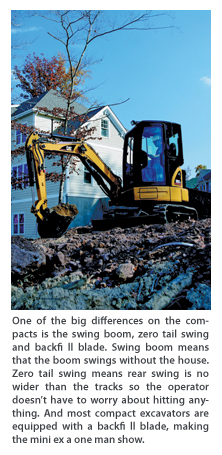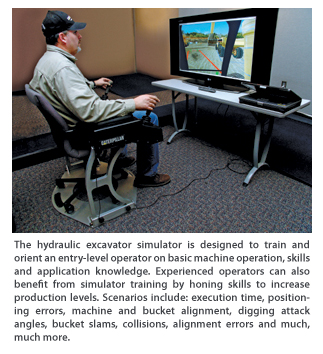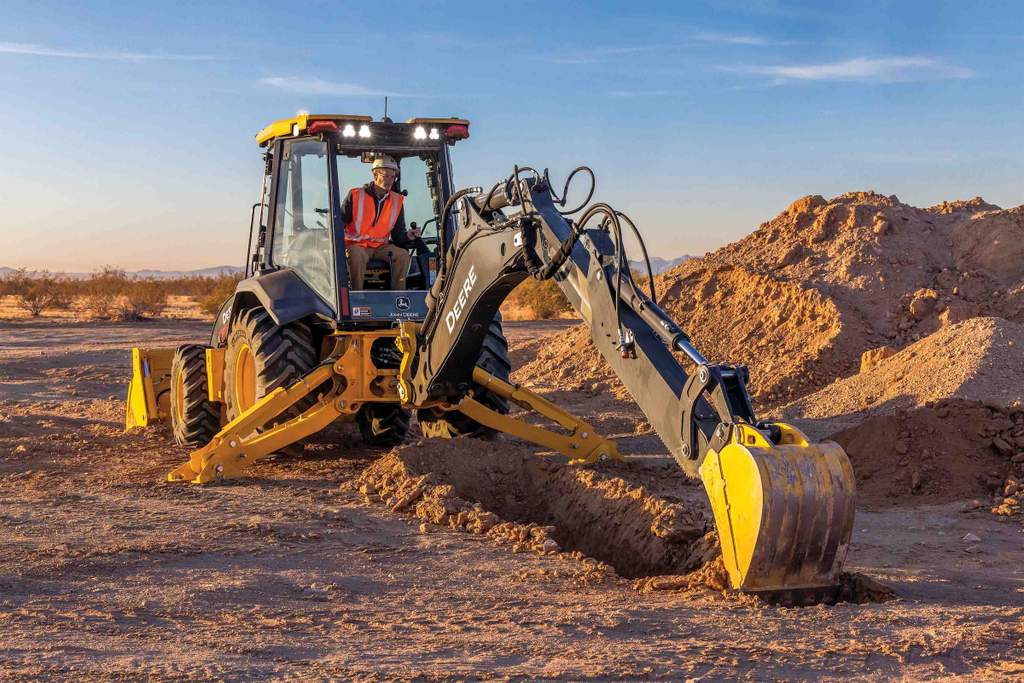Cue the Training Montage

A look of determination comes across the face of your operator in training. Cut to classroom equipment and safety instruction — diligently taking notes with an understanding nod. Pull back from a bead of sweat running down your operator’s face as he tries to dig on grade. A lot of work went into crafting his trade — from walking the jobsite to scope out the work to reading the excavator’s owner’s manual during breakfast, lunch and dinner. His grade work is now perfect and placing pipe is no problem. The job’s done perfectly with no setbacks or injuries. A thumbs up from the foreman as your operator walks into the sunset, fist raised.

Unfortunately, it’s going to take longer than two minutes for a new operator to learn the ropes — no matter how loud you blast the “Rocky” theme song over the jobsite loud speaker. It takes time and hard work to learn the nuances of an excavator and get to know the crew and operations of a utility jobsite. Unless an employee has years of operation experience, chances are they aren’t going to get their hands on the excavator’s digging sticks.
“Typically what happens is that someone is hired as an unskilled or general laborer, but they show some mechanical ability that people recognize and they want to learn how to operate a machine,” says Greg Strudwick, certified NUCA safety instructor and president of Greg Strudwick and Associates, which provides safety consulting to utility contractors. “It’s like little boys wanting to play with Tonka toys. They start bugging the operators during lunch hours or other downtime to run the machines. The operators let them be their swampers [a laborer who assists the operator]. They start to learn about operation by being around the machine and watching other operators.”
Your excavator operator is one of the major factors that dictate your project’s profitability. Is he on grade? Is he using the right bucket to make sure he’s getting the most productivity out of every cycle? Is he digging to keep his crew and the buried utilities safe? All of these questions ultimately add to your project’s bottom line.
In the pantheon of equipment operation, the excavator is typically third in line. The road to operation starts with smaller equipment, such as a vibratory roller. From there, the operator will step up to a loader, like a wheel loader or skid steer. Loaders are often paired with excavators in dig and load options, which only strengthens the excavator’s siren song. If dozer operation isn’t next, the operator typically takes control of the excavator.
“Ultimately in a utility crew, the next step up from excavator operator is the foreman,” says Strudwick. “A lot of times he moves into a managerial position because he basically knows how to run that jobsite. He’s sitting in a seat where he’s watching the other operations all at one time. Most of your site foremans and superintendents came from the seat of an excavator.”
The Experiencing of Education
The excitement from the aroma of recently pierced earth is quickly overcome by first day jitters. The new recruit has been assigned to one of your most trusted supervisors and his skills are put to the test installing new utility lines for a subdivision. His grade is decent, but his hands are shaky — he’s nervous and a little rusty. Your foreman cautiously walks over and motions to him to turn the machine off before critiquing his work.

“You can’t grow all your operators because the turn-over rate might be too high,” Strudwick explains. “What you do is blend. You have your senior operators that you know are going to be moving on at some point and some operators you already know are going to be transients. They’ll work for you for two years and then they’re gone. And then they come back two years later.”
Whether you have a green operator-to-be or a rusty seasoned vet, there are several ways to whip them into shape outside of jobsite experience. Technology drives the latest in operator training. For classroom work, there are online options such as John Deere University (http://jdu.deere.com). Twenty-four hours a day, seven days a week operators can hop online and complete training modules that focus on safety, how to operate the machine and how to conduct daily service checks.
“The operator training courses are highly interactive with numerous simulations to virtually practice with the machine controls and how to maximize productivity with those controls,” says Jonathan Goodney, manager of Learning Technology for John Deere. “All courses are available in English with many also offered in Spanish and French. And a training coordinator at the customer’s facility can track test scores and manage the records of all learners.”
There are also programs that are in-depth how-to’s that go from basic info to the nitty-gritty specifics. For example, the National Utility Contractors Association’s (NUCA) Foundation for Education and Research’s Pipelayer Series is a five-part pipe installation course scripted by contractor volunteers on NUCA’s Education Committee. The first two parts that focus on Jobsite Layout and Excavations, Trenching, Manholes and Backfilling are now available, with the other three chapters — Working with Pipe, Surveys and Grades and Testing and Chlorination — still in production. The computer-based training DVD gives employers the opportunity to train on days when field conditions put a halt to production or during any down time.
If your recruits have more trouble operating a computer than an excavator, training DVDs and videos are available from the likes of John Deere, NUCA and Vista Training Inc., a company based in Waterford, Wisc., that provides training solutions for people involved in earthmoving, excavating and mining applications.
“These are great videos to watch before you ever get on a machine,” Goodney says. “On our newer products, the DVD videos also come equipped with an iPod size version of the video, as well as a PowerPoint version that will fit nicely into a presentation if you are developing a training program. The iPod version is nice to download and take up into the cab with you as you learn the controls, especially if you’re trying to train someone who speaks a different language.”
Sharpening Skills with Technology
It’s like something out of a pulp sci-fi story — people trained in a virtual world where even the most reckless operation results in a mere Game Over screen instead of jobsite casualties. But that training technology is starting to come into its own, and no you don’t have to wear a futuristic silver uniform.
Both John Deere and Caterpillar have unveiled the latest leap in training — virtual simulation of a jobsite, complete with a full set of excavator controls. These hydraulic excavator simulators allow new operators to cut their teeth in a safe environment, learning difficult maneuvers repeatedly until they have fully mastered and are ready for the jobsite.
“Simulation training can decrease operator anxiety in a controlled environment, allowing students to learn specific safe operating procedures and how to avoid bad habits,” says Larry Estep II, equipment training solutions manager for Caterpillar. “With Caterpillar simulation training, an instructor can train multiple operators at one time. HR and recruiting organizations can use simulation products to screen new operator hires, track operator training performance through built–in testing and address ergonomic issues.”
If you’ve ever picked up your kid’s Xbox controller and let him “win” in Halo, you’ll be happy to know that you have the upper-hand on simulators, thanks to the true-to-life excavator controls. The software is typically run on Windows-compatible computers and comes with the frame and controls. Install the software, put an office chair in the frame of the controls, connect your computer to a screen and you’ve created a virtual jobsite in your office.
“These simulators concentrate on learning the hand/eye coordination of doing several tasks safely in a virtual jobsite,” says Goodney. “Since you learn operator technique, not just machine specific information, it may help you train on other manufacturer’s excavators as well. You can also switch between backhoe- and excavator-style controls. The strong message with [simulator] technology is that you are not burning fuel while you learn operator technique, and you won’t hurt anyone or damage equipment in real life.”

If you aren’t into techno-training, there’s the most interactive of all systems — instructor-led operator training. Offered across the board from manufacturers like Cat, John Deere and Komatsu (to name a few) to associations like NUCA, instructor-led training lets operators develop the confidence necessary to demonstrate correct planning and operation techniques for customized machine applications.
“Normally, we recommend that you get a group together — 10 or more — and we’ll train on a Friday or Saturday,” says Strudwick. “You’ll get to work your four-day week with production and then you can have that one day. At that point, many operators are looking for advanced training. You can go over different aspects of the excavator. Bucket size for example — it has a huge affect on production when you use the correct bucket. It determines how much money you spend on your embedment process and backfilling and other things of that nature.”
“Competent Person training is probably the most important advanced training,” adds Ryan Schmitt, president of Petticoat-Schmitt Civil Contractors Inc., a Jacksonville, Fla.-based contractor. “It is important for the operator to know how to excavate a safe trench.”
Though you can’t speed up time with quick cuts to get your guys operating perfectly before you’re done with your morning coffee, you will start to see their progress. There’s no downside to implementing an operator training system — your operators will become lean, mean, productivity-producing machines. They’ll go the distance to make sure the job is done correctly and safely.
Jason Morgan is contributing editor to Compact Equipment, based in Peninsula, Ohio.
Pro Tips by Eric Mayfield
Certified Dealer Instructor, Edwards Demonstration and Learning Center
-
Always call for utility locates. It is the law to contact One-Call and have all utilities located before any excavating takes place.
-
Be aware of all ground personnel.
-
Dig staying in the proper working range from the top down removing material in layers.
-
Properly size the machine to the job, the bucket to the machine and material.
-
Properly equip the machine for the job — hammer, compactor, thumb, grapple, buckets, coupler or shears.
Pro-Tips by Ryan Schmitt
President of Petticoat-Schmitt Civil Contractors Inc.
-
Put operators in Competent Person training. They should be aware of the different soil types.
-
Create a culture where they feel comfortable, requesting that their machine be kept in good repair, especially for safety-related issues.
-
Encourage daily inspection of machines prior to starting work.
-
Set internal standards for operator experience.
-
Operators should not underestimate the damage and injuries that can occur when getting on a smaller machine. Often small excavators are used in tight quarters and are susceptible to property damage and bodily injury. When getting on a larger machine, the operator must be aware of how high the boom can go which makes overhead power lines a huge concern.
Mini Ex(perts)
Tips for the Compact Trade of Excavation
1. Mini hydraulic excavators can dig and swing very quickly. Being a narrow machine, they can have less side to side stability compared to larger machines. Since mini hydraulic excavators are small, many people get the perception it takes less skill to operate compact equipment. At times, an inexperienced operator is placed on a mini hydraulic excavator. Compact excavator operators need to consider the same hazards and safety issues that impact larger machines, especially when working in confined spaces. — Jeff Henderson, manager of equipment training solutions at Caterpillar.
2. The big difference in excavator sizes are the material production, lifting capacities and area to work in. Both the compacts and the large excavators have the same controls so operators can jump off of one and onto the other. Compacts are used for small jobs such as pot holing, small building footings, excavation inside buildings, utility services from main lines to resident housing and many other jobs depending on the operator’s imagination. Most excavation will be less than 4 ft in depth, use PVC pipe and no trench box. Large excavators are used for excavation for deep pipe, lifting heavy trench boxes and heavy pipe, mass excavation and loading large trucks. The area to work determines machine size. For example, if a contractor has a confined space and no room to swing, a compact works great. The biggest thing to watch out for is inexperienced operators jumping on a mini excavator and being too confident because of the size of the unit. They are not as intimidated with the small machines and can run into trouble quickly. — Jonathan Goodney, manager of learning technology at John Deere.
3. Operators should not underestimate the damage and injuries that can occur when getting on a smaller machine. Often small excavators are used in tight quarters and are susceptible to property damage and bodily injury. When getting on a larger machine, the operator must be aware of how high the boom can go, which makes overhead power lines a huge concern. — Ryan Schmitt, president of Petticoat-Schmitt Civil Contractors Inc., Jacksonville, Fla.





Comments are closed here.